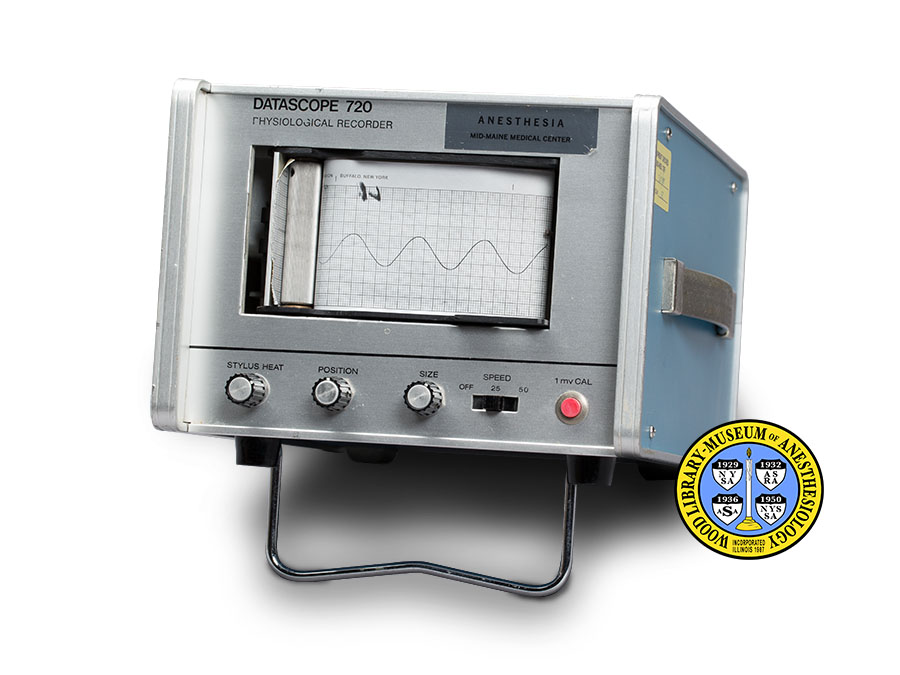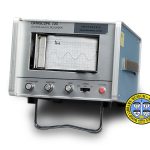Datascope 720
Datascope 720 Physiological Recorder
Anesthesiologists monitor the vital signs of their patients during surgery. American engineer and businessman Mr. Lawrence Saper (b. ca. 1928) began building his first medical device, a cardiac monitor intended for use by anesthesiologists, in 1964. That same year he founded Datascope Corporation to manufacture his designs. The company has made numerous kinds of patient monitors and other medical equipment.
Datascope made a series of Physiological Monitor models in the 1970s, and might have paired them with the model 720 Physiological Recorder. The apparatus uses a metal stylus or "pen" to trace vital signs on a moving strip of thermal paper. From the 1970s through the 1990s, the model 720 was used to record blood pressure during clinical studies of adult and pediatric patients, as well as studies in the fields of aerospace medicine, sports medicine and veterinary medicine.
Catalog Record: Datascope 720 Datascope 720
Access Key: amxw
Accession No.: 1988-04-15-1 B
Title: Datascope 720 Physiological Recorder.
Corporate Author: Datascope Corporation.
Publisher: Saddle Brook, NJ: Datascope Corp., [between 1970 and 1981].
Physical Description: 1 monitoring device : metals (including aluminum), plastics, paper ; 21.5 x 20.5 x 272 cm.
Subject: Blood Pressure Determination – instrumentation.
Subject: Blood Pressure Monitors.
Subject: Monitoring, Intraoperative – instrumentation.
Subject: Monitoring, Physiologic – instrumentation.
Note Type: General
Notes: The first year in the date range is based on the year that Datascope introduced the Model 850 monitor. The last year in the date range is based on the year that Datascope introduced the Accutorr, a monitor with a built-in recorder.
This description orients the apparatus horizontally, with the tracing and controls facing forward and the plastic handle on the operator’s right. When carried by the handle, the apparatus would hang vertically. The dimensions given are the maximum, with the wire stand and the inserted electrical cord both fully extended.
Note Type: Citation
Notes: Balvanera A, Robledo JL, Espinosa de los Monteros A. Neuroleptanalgesia in acute myocardial infarction. Texas Heart Institute J. June, 1984;11(2):136-145.
Note Type: Citation
Notes: Ito K, Ramirez-Schon G, Shah PM, Agarwal N, Delquercio LR, Reynolds BM. Myocardial function in acute pancreatitis. Ann Surgery. July, 1981;194(1):85-88.
Note Type: Citation
Notes: National EMS Museum. Datascope 850. http://www.emsmuseum.org/virtual-museum/Equipment/articles/398245-1971-EKG-Monitor-Datascope-850. Accessed July 21, 2016.
Note Type: Citation
Notes: Rampil IJ, Smith NT. Computers in Anesthesiology. In: Saidman LJ, Smith NT, eds. Monitoring in Anesthesia, 2nd ed. Boston: Butterworth Publishers, 1984:441-496.
Note Type: Citation
Notes: Rodengen JL, Hubbard RF. Innovation is the Best Medicine: The Extraordinary Story of Datascope. Fort Lauderdale, FL: Write Stuff Enterprises, Inc., 2004.
Note Type: Citation
Notes: Shaw, TJI. The Swan-Ganz pulmonary artery catheter. Anaesthesia. July, 1979;34(7):651-656.
Note Type: Citation
Notes: Tanswell AK, Clubb RA, Smith BT, Boston RW. Individualised continuous distending pressure applied within 6 hours of delivery in infants with respiratory distress syndrome. Arch Dis Child. 1980;55:33-39.
Note Type: Physical Description
Notes: One monitor; With the wire stand folded, the housing of the unit measures approximately 16 x 20.5 x 29.5 centimeters; There are two associated removable parts, an instrument cable and an electrical cord; The cable has a metal plug at each end, and is approximately 72 centimeters long; The electrical cord is approximately 246.5 centimeters long; The top, base, and sides of the unit are covered in blue plastic panels, and the edges of these panels are clad in aluminum; The front panel is made of aluminum;
The top of the unit bears an embossed plastic tape ownership label that reads: “THAYER ANESTHESIA”; A flexible, gray plastic carrying handle is attached to the center of the right-hand side; In the upper left corner of the right-hand side is an adhesive inspection label dated “3/31/88”; The left-hand side is unmarked; The base of the unit is marked in black indelible ink: “THAYER [new line] ANESTHESIA”; The base holds a folding stand made of a single length of thick metal wire; This wire is anchored at each end in plastic parts that act as supporting feet near the front edge of the base; Two gray rubber bumpers act as supporting feet near the back edge of the base;
The front panel is marked near the upper left corner: “DATASCOPE 720 [new line] PHYSIOLOGICAL RECORDER”; To the right of this is an adhesive ownership label that reads: “ANESTHESIA [new line] MID-MAINE MEDICAL CENTER”; There is a rectangular opening in the center of the panel, which displays the thermal paper tracing; A metal stylus is mounted to the right of the paper; The exiting end of the paper is threaded through a rubber platen on the left; Below this opening there is a row of five controls; That on the far left is a dial labeled “STYLUS HEAT”, next is a dial labeled “POSITION”, next a dial labeled “SIZE”, then a switch labeled “SPEED”; The speed switch has three settings: “OFF”, “25” and “50”; On the far right is a red button labeled “1mvCAL”;In the center of the back panel is a label that reads: “TYPE 720 [new line] PHYSIOLOGICAL [new line] RECORDER [new line] 115 V, 60Hz, 0.35A, 40W [new line] Serial No. 1427 [new line] DATASCOPE CORP. [new line] Saddle Brook, New Jersey”; Above this is an adhesive ownership label that reads: “THAYER HOSPITAL 3170”; To the right of these center labels there are two input receptacles, one above the other; The upper of these two is labeled “1.0v/cm [new line] (TRACE 1) [new line] INPUT”; The lower of these two is labeled “0.1v/cm [new line] (TRACE 2) [new line] INPUT; To the right of the center labels is a receptacle labeled “1mvCAL.OUT”; Below this is a plastic stopper that fills a receptacle labeled “MARKER INPUT”; Below the center labels is a row of three components; That on the left is a red button marked “3AG-1AMP”, in the center of this row is a three-prong receptacle marked “POWER INPUT”; That on the right is a plastic connector marked “REMOTE RUN”.
Note Type: Reproduction
Notes: Photographed by Mr. Steve Donisch, January 11, 2016.
Note Type: Acquisition
Notes: Gift of Kenneth Green, M.D.
Note Type: Historical
Notes: Anesthesiologists monitor the vital signs of their patients during surgery. American engineer and entrepreneur Mr. Lawrence Saper (born in 1928 or 1929) began building his first medical device, a cardiac monitor intended for use by anesthesiologists, in 1964. That same year he founded Datascope Corporation to manufacture his designs. The company has made numerous kinds of patient monitors and other medical equipment.
The model number, 720, does not provide a clear indication of the date when this device was introduced. Datascope’s model 850 Physiological Monitor was introduced in 1970, while its model 790 Recorder was introduced four years later, in 1974. The model 790 Recorder was intended to be used as a companion to Datascope’s M/D2 defibrillator, which had been introduced one year earlier, in 1973. It would be reasonable to suppose that the 720 Physiological Recorder may have predated the 790 Recorder. In 1981, Datascope introduced a microprocessor-based blood pressure monitor, the Accutorr, which had a built-in component that produced a paper record. The Accutorr was also an optional module in Datascope’s later multiple-function monitors.
Datascope made several devices called Physiological Monitors in the 1970s, including the models 850, 860, 865 and 870. The model 720 Physiological Recorder might have been intended as a companion to one or any of these. The model 720 uses a metal stylus or “pen” to trace vital signs on a moving strip of thermal paper. The cataloger has found no documentation of its functions or operation, other than brief mentions of the 720 in medical and technical literature. From the 1970s through the 1990s, the model 720 was used to record blood pressure during clinical studies of adult and pediatric patients, as well as studies in the fields of aerospace medicine, sports medicine and veterinary medicine.
Note Type: Publication
Notes: Institute of Electrical and Electronics Engineers. Proceedings: International Conference on Cybernetics and Society, Denver Hilton, Denver, Colorado, October 8-10, 1979. New York: Institute of Electrical and Electronics Engineers, date unknown:166.
Note Type: Publication
Notes: Journal of Sports Medicine and Physical Fitness.1976;16(2-4):294.
Note Type: Exhibition
Notes: Selected for the WLM website.


